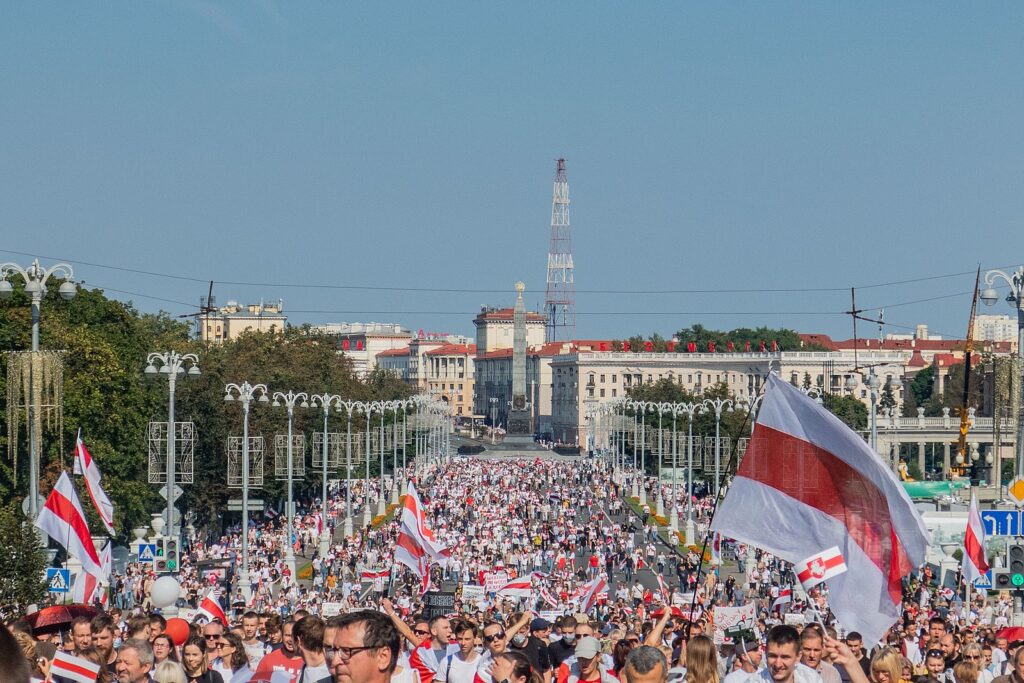Words by Amy Holden
On 9 August Belarus held their elections, resulting in a sixth consecutive term for their President, Alexander Lukashenko. However, since the results, the country has been flooded with protests and demonstrations (some involving over 100,000 people) regarding a number of issues, with many demanding a new election.
The protests against Alexander Lukashenko, who became President in 1994, are caused by concerns held by Belarusians, over widespread poverty, corruption, low pay and the current coronavirus pandemic. Previously, Alexander Lukashenko in April claimed that no Belarusian would die of COVID-19 and suggested drinking vodka and using saunas to prevent the virus. Now, over 600 have died, and tens of thousands are infected, in Belarus, the pandemic has only compounded bad-feelings. Officially, the results show a landslide victory of 80% for Lukashenko, which opposition movements vigorously refute. The night of the results was marked by around 3000 arrests, with rubber bullets and tear gas deployed by riot police against protestors.
Protests have continued for over three weeks, despite President Lukashenko’s attempts to stop the demonstrations with security forces, rather than negotiating with the council created by opposition leader Sviatlana Tikhanovskaya (of which some members were arrested). Sviatlana Tikhanovskaya fled the country, and, communicating via video from Lithuania, said that she wanted new elections and President Lukashenko’s security officers to change sides to strengthen their cause. Her attempt to get the results annulled was rejected by the Belarusian Supreme Court. Sviatlana Tikhanovskaya, now President Lukashenko’s rival, entered politics as other opposition figures were arrested or exiled, including her husband Sergei Tikhanovsky, whose campaign she is continuing.
However, the attempts to subdue the protests are simply fuelling more, and we are seeing the conflict escalate with allegations of police brutality, overcrowded jails and calls for strikes becoming widespread across Belarus. Furthermore, on 17 August, TV staff walked out due to the situation (with TV services traditionally being loyal to the government), alongside many high-profile resignations. In many cities, the official flag has been replaced with the historic white and red flag, which has now started to represent the resistance movement, along with solidarity chains standing against the administration’s actions.

The use and control of the technology are also transforming how the protests against the government happen. Despite Lukashenko trying to cut internet access, the protestors have moved to applications that do not require a web connection. Having previously used social media to coordinate the groups and expose state and police violence, telegram services such as ‘NEXTA’ are being utilised for coordination purposes, as well as to share news on police beatings being leaked by opposition telegram services.
However, the unease does not stop at Belarus, with many countries voicing their views on the situation. President Lukashenko has claimed that NATO is building up forces in bordering Poland and Lithuania and that they intend to split Belarus up with a new President. In response, NATO denied that their troops were there for any reason other than defence, urging President Lukashenko and the current administration to recognise the human rights of Belarusians and hold free elections. Furthermore, the European Union and the United States have disputed the results and condemned the subsequent actions of the police and security forces, with German Chancellor Angela Merkel commenting that President Lukashenko refused to speak with her.
Most recently, Russian President, Vladimir Putin announced that the Kremlin would send military and law enforcement into Belarus to support President Lukashenko if they felt the situation required. A Kremlin spokesperson refused to clarify the size and type of the forces that would be deployed, of which Chancellor Merkel said she hopes does not occur. Alongside promised support, President Lukashenko and the Kremlin have been discussing economic aid, including the refinancing of $1 billion Belarusian debt owed to Russia.
Given the stances of other states and global organisations, as well as its previous relations with Europe, the situation in Belarus is not only ever-changing, but one that is likely to continue for some time, with neither side showing signs of conceding, and unrest continuing to mount.

